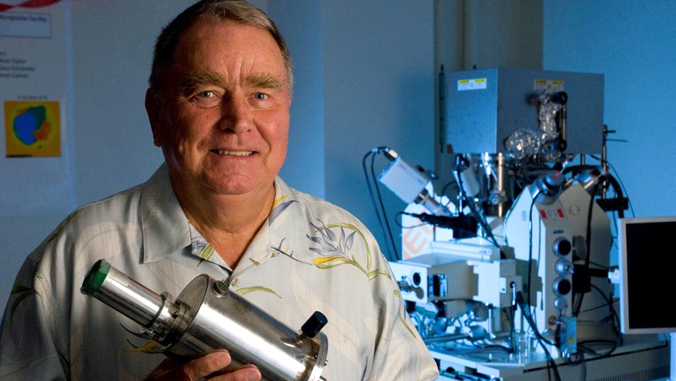
Klaus Keil, a planetary scientist emeritus at the Hawaiʻi Institute of Geophysics and Planetology (HIGP) at the University of Hawaiʻi at Mānoa, has been elected a Legends Fellow of the Microanalysis Society (MAS).
MAS members are investigators and engineers who have contributed to the development and application of an instrument called the electron probe microanalyser (EPMA) to study the compositions of very small samples of rocks, ceramics, metallurgical and forensic samples and more. The Legends Fellow distinction was established this year to recognize eminent scientists, engineers and technologists in the field of microanalysis who have distinguished themselves through outstanding research, outreach, teaching and service.
This first group is known as the Legends Class of 2018.
Keil pioneered the use of the electron microprobe and its application and calibration to determine the chemical compositions of minute mineral grains in meteorites, lunar, Martian and terrestrial samples. With two collaborators, he has also developed and built the first energy dispersive spectrometer for the detection of X-rays in an EPMA. The device has revolutionized the analysis with the EPMA, and is not only a part of thousands of electron microprobes in world laboratories, but also of almost every scanning and transmission electron microscope.
“I am interested in the origin of solid materials in the solar nebula early in the history of the solar system, and the subsequent accretion into, and evolution of, planetesimals and asteroids,” said Keil. “I also study the origin and evolution of Earth’s Moon and the planet Mars. This research is carried out on meteorites from asteroids, (the) Moon and Mars, and on returned lunar samples.”
The aim of his research is to understand the processes that took place in the solar nebula, the cloud of material that birthed the solar system, and processes, such as volcanism, that shape various solid bodies in the solar system.
“I am very honored to receive this newly created and highest recognition of the Microanalysis Society,” said Keil. “In addition, to be named a Legends Fellow is something special, because one is thus in the company of legendary scientists who have contributed to the advancement of electron probe microanalysis and development of this incredibly important field of analytical science.”
Keil came to UH Mānoa from the University of New Mexico in 1990 as a professor of geology. Subsequently he served as director of HIGP and interim dean of the School of Ocean and Earth Science and Technology. Keil has authored and co-authored more than 685 scientific papers and has an asteroid (Asteroid 5054 Keil) and an extraterrestrial new mineral (keilite) named after him.
MAS will hold an awards ceremony to honor the Legends Class of 2018 in Baltimore in August.
—By Marcie Grabowski

